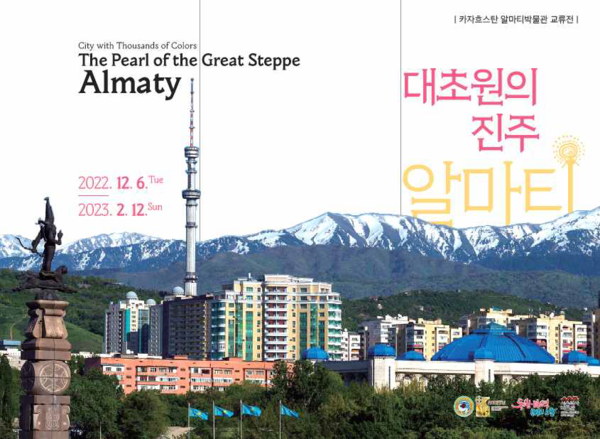Opening of Seoul-Almaty Joint Exhibition “the Pearl of the Great Steppe”

The Seoul Museum of History (Director Kim Yong-seok), in collaboration with the Almaty Museum (Director Lyazzat Sagindikova), will hold a joint exhibition, The Pear of the Great Steppe, from December 6 (Tue) to February 12 (Sun) next year in the lobby on the first floor of the Seoul Museum of History. This exhibition, planned to commemorate the 30th anniversary of the establishment of diplomatic relations between Korea and Kazakhstan, introduces the history and traditions of Kazakhstan and its former capital and largest city, Almaty. Kazakhstan is a country that embraces the vast grasslands of Central Eurasia and is called the “giant of Central Asia.” As can be seen from its geographical structure, it served as a crossroads connecting East and West civilizations and became the center of Eurasian history.
Almaty, which means “father of apples” in Kazakh, was the capital and largest city of Kazakhstan until Astana became the capital in 1997. It is still maintaining its status as a center of science, culture, industry and finance. <The Pear of the Great Steppe> lobby exhibition curated by the Almaty Museum, Kazakhstan's representative city history museum, opens to Seoul citizens for the first time about 100 ethnographic artifacts from the Almaty Museum's collection. Through this exhibition, you can get a glimpse of the life of Kazakhstan, which inherits the tradition of the Turkic people who lived nomadic life in the steppe.
The exhibition consists of two main parts: nomadic civilizations and Almaty's yesterday and today:
[Daily life] Daily necessities and clothes such as carpets, dishes, and storage boxes used in yurts, a symbol of nomadic civilization, are exhibited. You can see practicality and aesthetic sense of nomadic life through a scale model of a yurt.
[Hunting skills] Introducing artifacts related to Kazakhstan's long tradition of hunting golden eagles (Berkut) and horses, which were an essential means of transportation and main food for nomadic life.
[Jewelry craftsmanship] Precisely crafted silver jewelry for women and Dirham coins, which represent the history of Almaty, are exhibited. Kazakhstan, which is rich in metal ore, produced various metal crafts based on advanced metal processing technology and in this exhibition, you can see women's accessories such as 'Shashbau' and 'Sholpy', women's head ornaments, 'Onirzhiek', and earrings, bracelets and rings.
[Music of the steppe] Introducing traditional musical instruments that shared the joys and sorrows of nomads. You can experience various traditional musical instruments such as Dombra, Zhetygen, and Kylkobyz of Abai Kunabaev, the national poet and philosopher of Kazakhstan.
Finally, in [Almaty's yesterday and today], you can see Almaty, a city that shines in thousands of colors, through photos of Almaty's landmarks and people.
The Almaty Museum, which jointly organized the exhibition, is a city history museum belonging to the Almaty City Museum Association. It is a city museum that opened in 2002 using the building of an orphanage. It houses about 40,000 artifacts, including ethnographic relics, currency, photographs, documents, and paintings, showing the past and present of Almaty. Prior to the opening of the exhibition, Kim Yong-seok, director of the Seoul Museum of History, said, “Kazakhstan has a special meaning in central Eurasia. I am delighted to be able to introduce the beautiful pearl-like tradition and culture of Kazakhstan to citizens. These days, when understanding and respect for various cultures are needed, we invite you to Kazakhstan, which is a bit unfamiliar.”
The opening ceremony will be held on December 6th (Tuesday) at 3:00 pm in the lobby of the Seoul Museum of History. A delegation from Kazakhstan including Mailybaev Gani Aidarovich, a director of Culture of Almaty, Bakyt Dyussenbayev, the Ambassador of Kazakhstan in Seoul and Ai Su Luu, a Seoul Metropolitan City councilor will attend to congratulate the opening of the exhibition. You can enjoy the exhibition for free, and opening hours are from 9:00 am to 6:00 pm on both weekdays and weekends. Closed on Mondays and January 1, excluding public holidays. For more information, visit the website of the Seoul Museum of History (museum.seoul.go.kr). (Inquiries: 02-724-0274)

